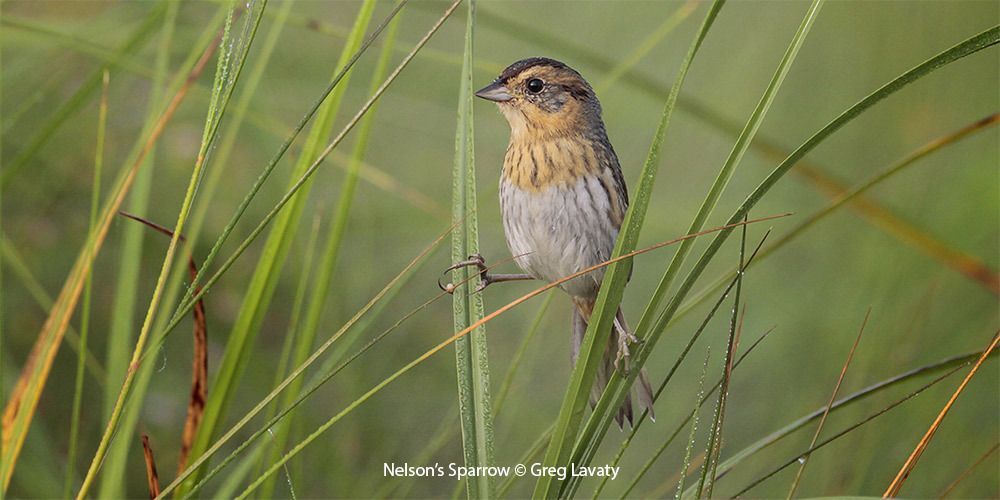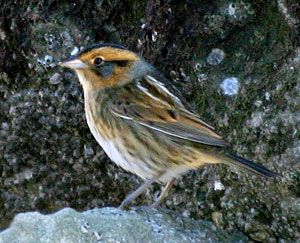
© Helen Baines
Nelson’s Sparrow
Ammospiza nelsoni
Family: (Passerellidae) New World Sparrows
Preferred Habitat: Saltmarshes.
Seasonal Occurrence: Common in winter; uncommon spring and fall.
Profile by Richard Gibbons: The Nelson’s Sparrow is a small, stocky songbird with an orange face, gray crown, and well defined white belly. Its neck and upper body are brown with white or gray streaks, while its breast and flanks have smudged brown streaks. Its brown tail is short and rounded with pointed tail feathers. Males are slightly larger than females, but their plumage is the same.
Nelson’s Sparrows are secretive birds which are common in coastal salt marsh habitat. They breed inland in the freshwater marshes of the northern Great Plains, in coastal marshes on the Atlantic coast from Quebec to Maine, and along the southern edges of both Hudson and James Bays. They migrate in the autumn to their wintering grounds in coastal salt marshes from New Jersey to Texas. Before they depart for the breeding grounds in Spring, their frying-pan-sizzle song can be heard emanating from coastal marshes. More adventurous birders can walk through coastal marsh grasses and hope to flush a Nelson’s Sparrow. Their weak flight and crash landing back into the grass is typical of Ammodramus sparrows.
Until 1995, the Nelson’s Sparrow and the Saltmarsh Sparrow were thought to have been the same species, the Sharp-tailed Sparrow. While Nelson’s and Saltmarsh sparrows look very similar and have an overlapping breeding range in Maine, they are distinct genetically and can be identified in the field by song.
These secretive marsh denizens spend the cooler months in Houston Audubon’s Dos Vacas Bird Sanctuary, Horseshoe Marsh Bird Sanctuary, Bolivar Flats Shorebird Sanctuary, and Mundy Marsh Bird Sanctuary.
Profile by Grace Yaros: Nelson’s Sparrows are small, colorful sparrows of wet, dense grasslands and marshes. They are white below with orange chests and sides, and their orange faces contrast with their gray cheeks. They are quite round, with short, spiky tails. LeConte’s Sparrows are similar in appearance, but can be distinguished from Nelson’s Sparrows by the white stripe running down the center of their crown (Nelson’s have a gray crown stripe). During the breeding season, males sing a relatively simple song that consists of a short, hissing trill. Males will also frequently perform flight displays during the breeding season, during which they sing a flight song that is relatively longer and more complex than their typical song.
There are three geographically distinct populations of Nelson’s Sparrows: two “Interior” forms that nest in freshwater wetlands in the Great Plains and along Hudson Bay and James Bay, and an “Atlantic” form that nests in saltwater or brackish tidal marshes along the northern Atlantic Coast in New England and Canada. All three populations spend the winter months in saltmarshes of the southeastern United States.
Loss of marsh and grassland habitat is the primary threat to these handsome sparrows. During the winter, you can find them on the Bolivar Peninsula at Bolivar Flats Shorebird Sanctuary and the 17th Street Jetty, as well as Horseshoe Marsh and along Frenchtown Road adjacent to Horseshoe Marsh.
Profile by Charlie Ayers: This week’s Beak of the Week brings pumpkin spice to the table, the Nelson’s Sparrow. The Nelson’s Sparrow is quite colorful for a member of this family. They can be identified by their bold yellow-orange faces, gray cheeks, and a neat band of yellow that runs across their lightly streaked bellies. These seldom seen sparrows are often hard to distinguish between their counterparts, the Saltmarsh Sparrow, so much so that up until 1998 they were lumped as one species known as the Sharp-tailed Sparrow. To differentiate between the two species, focus on the chests. Saltmarsh Sparrows will have heavier streaking and a much paler chest, lacking the orange wash of the Nelson’s Sparrow. Similarly, the face of the Saltmarsh Sparrow is much more sharply defined than that of the Nelson’s, with a brighter orange mustache that is contrasted by the pale chest and belly.
Nelson’s Sparrows spend all their time in marshes but where you find them will determine the type of marsh they use. Nelson’s Sparrows have a split range that generally does not intermingle. The Interior form, which can be found breeding in the freshwater marshes of the northern Great Plains, winters along the Gulf Coast from Texas to Florida, while the Atlantic form breeds along the Northern Atlantic Coast in saltwater marshes and overwinters along the southern Atlantic coast from Virginia to Florida. There’s talk of the Atlantic form becoming its own species. This split could be very important when it comes to their conservation. While overall the species is doing well, this Atlantic form is a much smaller population, possibly only about 25,000 individuals which almost exclusively nest in tidal marshes-an imperiled ecosystem in the Northeast. The splitting of this species could mean extra protection for the birds, which would not only improve their chances of survival but also many other threatened species that call these tidal marshes home.
Nelson’s Sparrows, like the majority of their family, spend most of their time on the ground foraging for insects. They will occasionally come up higher and perch on tall grass to eat the seeds at the top of grass stems - this is when it is easiest to spot them. You can find Nelson’s Sparrows at places like Bolivar Flats along the edges of the saltmarshes. During Houston Audubon’s most recent Bolivar Flats Beach Ramble, we spotted 14 individuals who popped out of the vegetation to forage and investigate what we were doing. Other places to check for Nelson’s Sparrows are Horseshoe Marsh Bird Sanctuary and the backside of Gast Red Bay Sanctuary where it opens up towards the marsh.
-
Cornell Lab of Ornithology
-
Field Guide
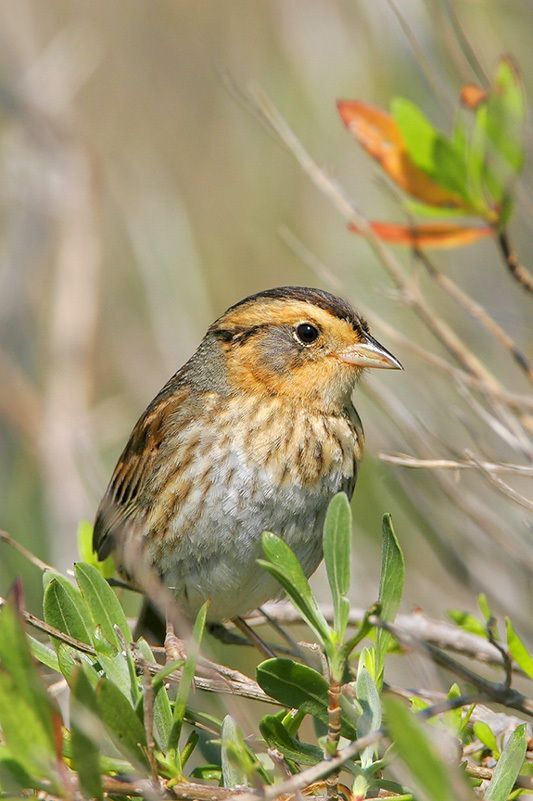
© Greg Lavaty, www.texastargetbirds.com
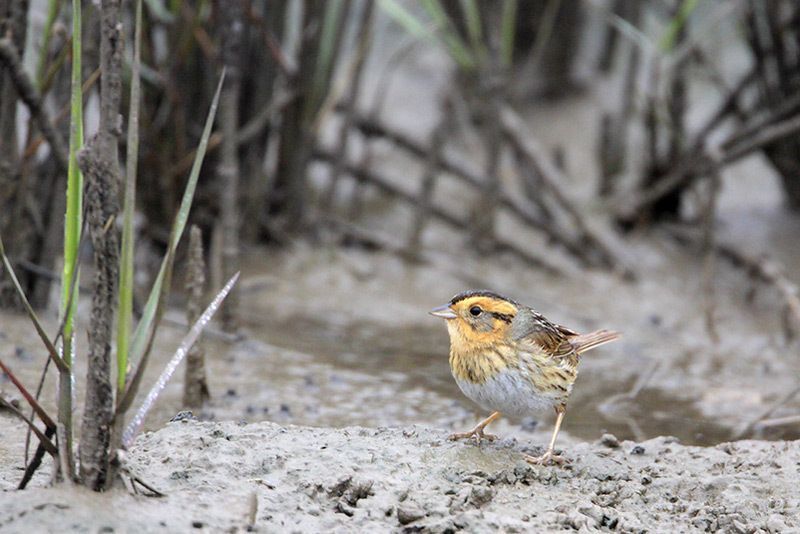
© Greg Lavaty, www.texastargetbirds.com
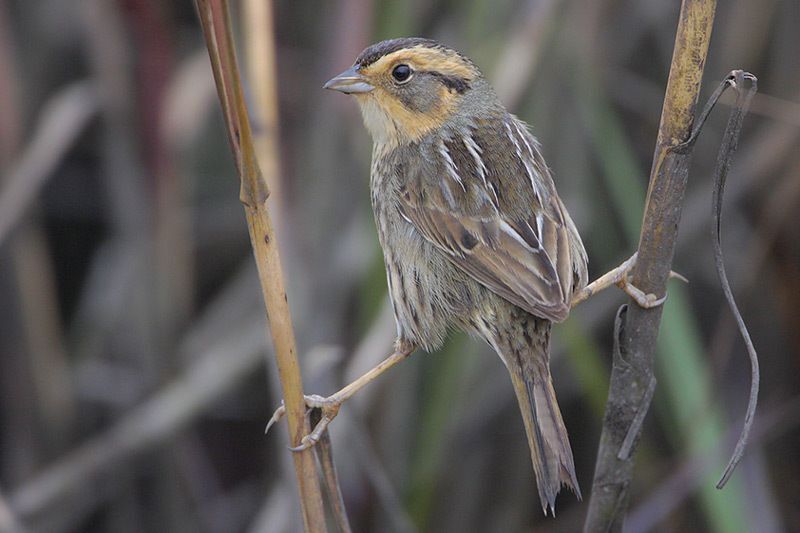
© Greg Lavaty, www.texastargetbirds.com
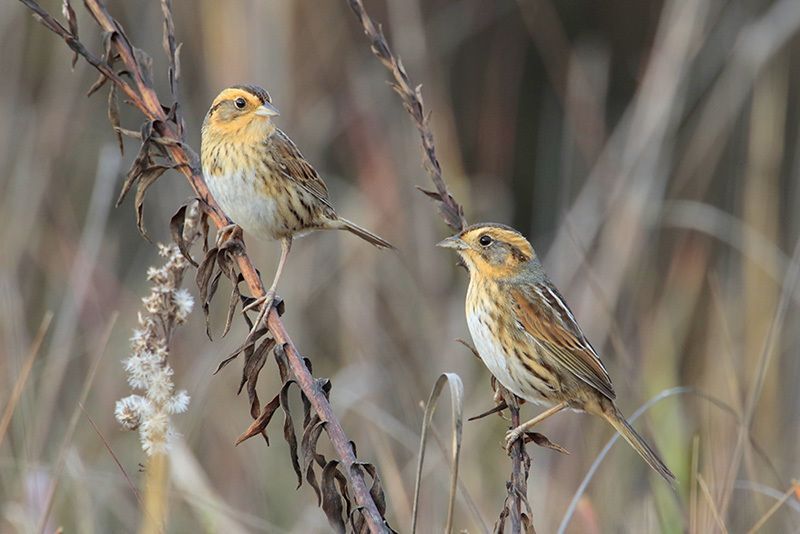
© Greg Lavaty, www.texastargetbirds.com

